Formula 1 News: 2024 Baku (Azerbaijan GP) Preview
Round 17 of the 2024 FIA Formula 1 World Championship takes the F1 Teams to the Baku City Circuit, home of the Azerbaijan Grand Prix.
–by Mark Cipolloni–
The city’s name in Arabic (Bākuh, Bākūh or Bākūyā) is derived from the Persian bād Kūbac, meaning “gust of wind.”
Azerbaijan first joined Formula 1’s calendar in 2016 with a street course laid out around the public roads of capital city Baku. Known for its fast, sweeping straights and tight corners, Baku provides a unique challenge that rewards precision, speed, and adaptability
The 6km circuit is among the longest on the current schedule, meaning the race track passes by the breadth of architecture for which Baku is famous, including the preserved ruins of the historic Old City, the imposing Soviet era blocks, and the glass-fronted skyscrapers that reflect Baku’s more recent developments.
The Baku City Circuit poses varying demands across its elongated layout. The first sector comprises lengthy straights that are interspersed with heavy braking zones and relatively basic 90-degree corners. The circuit narrows into a second sector which features tight and twisty sections adjacent to fortress walls as well as blind high-speed corners. That includes the narrowest section of any circuit on the calendar, the left-hand flick of turn 8, which is just 7.6 meters wide at its slenderest point.
The final sector almost exclusively runs along Neftchilar Avenue, a wide boulevard along which drivers plant the throttle for almost two kilometers, leading back to the start/finish line.
It means a compromised set-up is required, as teams attempt to maximize both aerodynamic prowess and straight-line speed. Keeping tires and brakes in their optimum window is also a challenge, particularly at turns 1 and 3, which come after lengthy full-throttle sections, while teams also need to be cognizant of the wind, with Baku known for its blustery conditions.
This will be the first Sprint weekend of the year, and with the changed format, the work teams and drivers have done in the simulator becomes even more important to make up for less practice time on track. The format of the weekend is a little bit different to the sprint events of recent years with Saturday now a self-contained day and Friday evening qualifying alone setting the grid for the Grand Prix on Sunday.
It will be vital to have a good car right from FP1. The circuit is challenging for the drivers and the engineers and with, very little time to set the car up ahead of Friday evening qualifying, there will be more uncertainty than normal when the cars enter Parc Ferme.
Azerbaijan joined Formula 1’s calendar in 2016 with a city-based event navigating the markedly different districts of capital Baku, where West and East meet adjacent to the Caspian Sea.
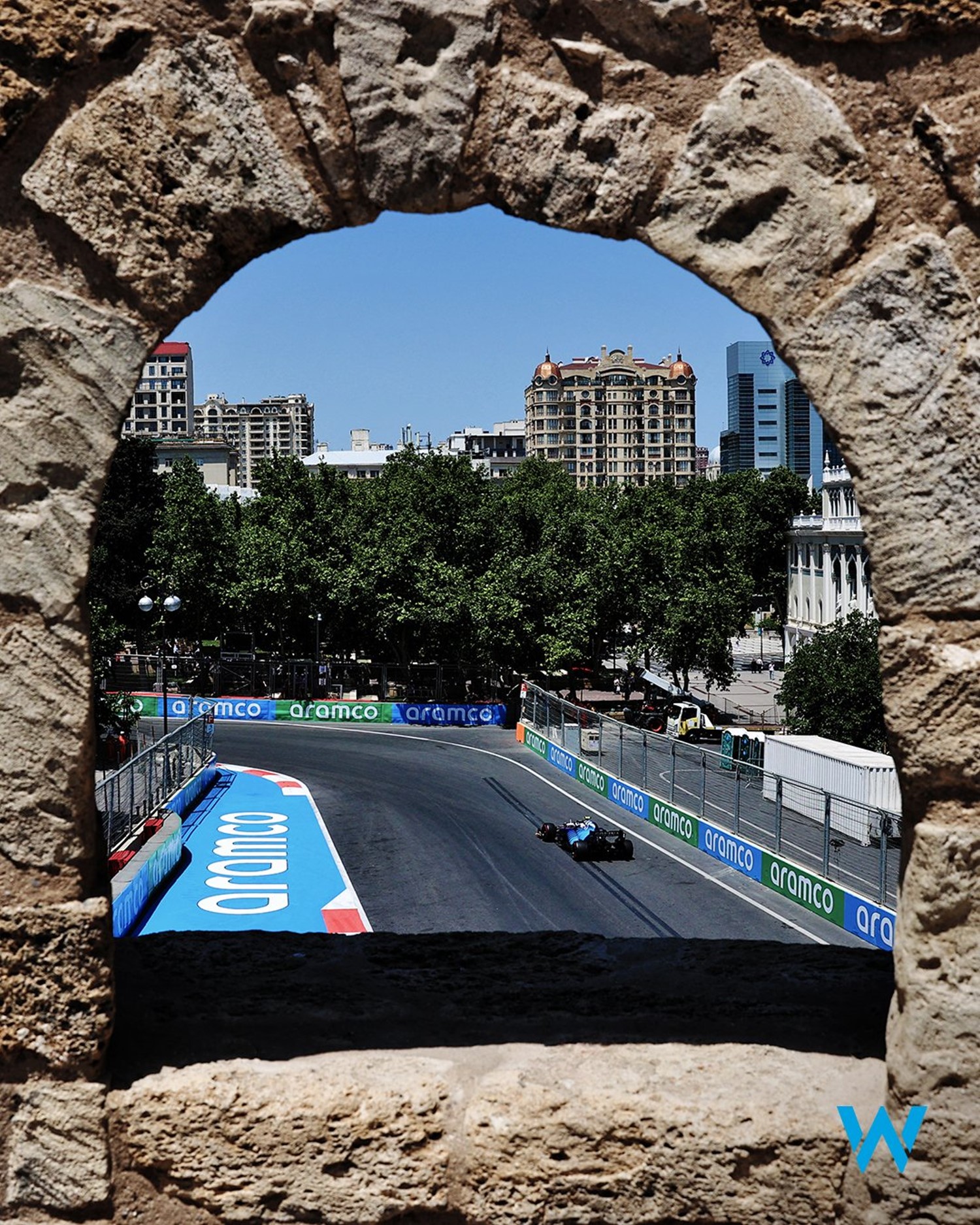

Baku sits as the lowest capital city in the world, at 28 meters below sea level, and has a history that stretches back a thousand years. That is reflected in the layout of its Formula 1 circuit, which winds its way alongside preserved ruins of the Old City, glass-fronted skyscrapers, and architecture from various periods that reflects Baku’s cultural legacy.
The one thing Baku never disappoints for is an exciting race, as we’ve seen many over the past years. The long straight and DRS zones really aid that.
The first sector of Baku City Circuit comprises lengthy straights punctuated by heavy braking zones and 90-degree corners, before a second sector that incorporates tight and twisty turns mixed with blind high-speed segments. That includes the notorious turn 8, at just 7.6 meters wide, where part of the fortress walls doubles up as an apex.
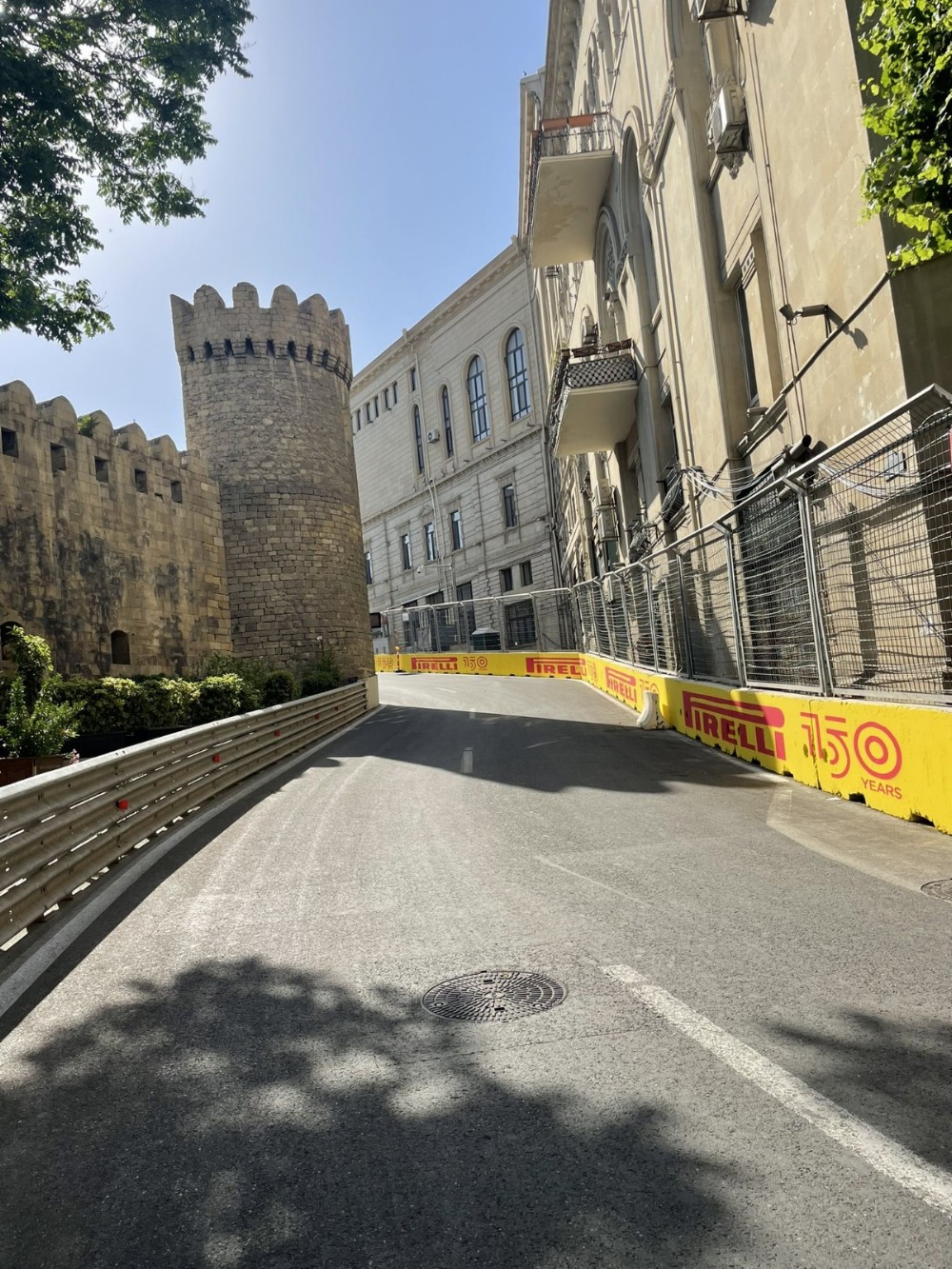
The final sector is almost entirely full throttle as drivers hurtle along one of Baku’s main thoroughfares at speeds approaching 360km/h, where the effect of a slipstream can be very profitable. Baku’s varying demands means a compromised set-up is required, as teams strive to maximize both aerodynamic prowess and straight-line speed, while ensuring tires and brakes are kept in their optimum operating windows.
With the Azerbaijan and Canadian events running on back-to-back weekends in June – it highlights the need for a regional calendar, as being proposed currently by F1 for 2023 onwards.
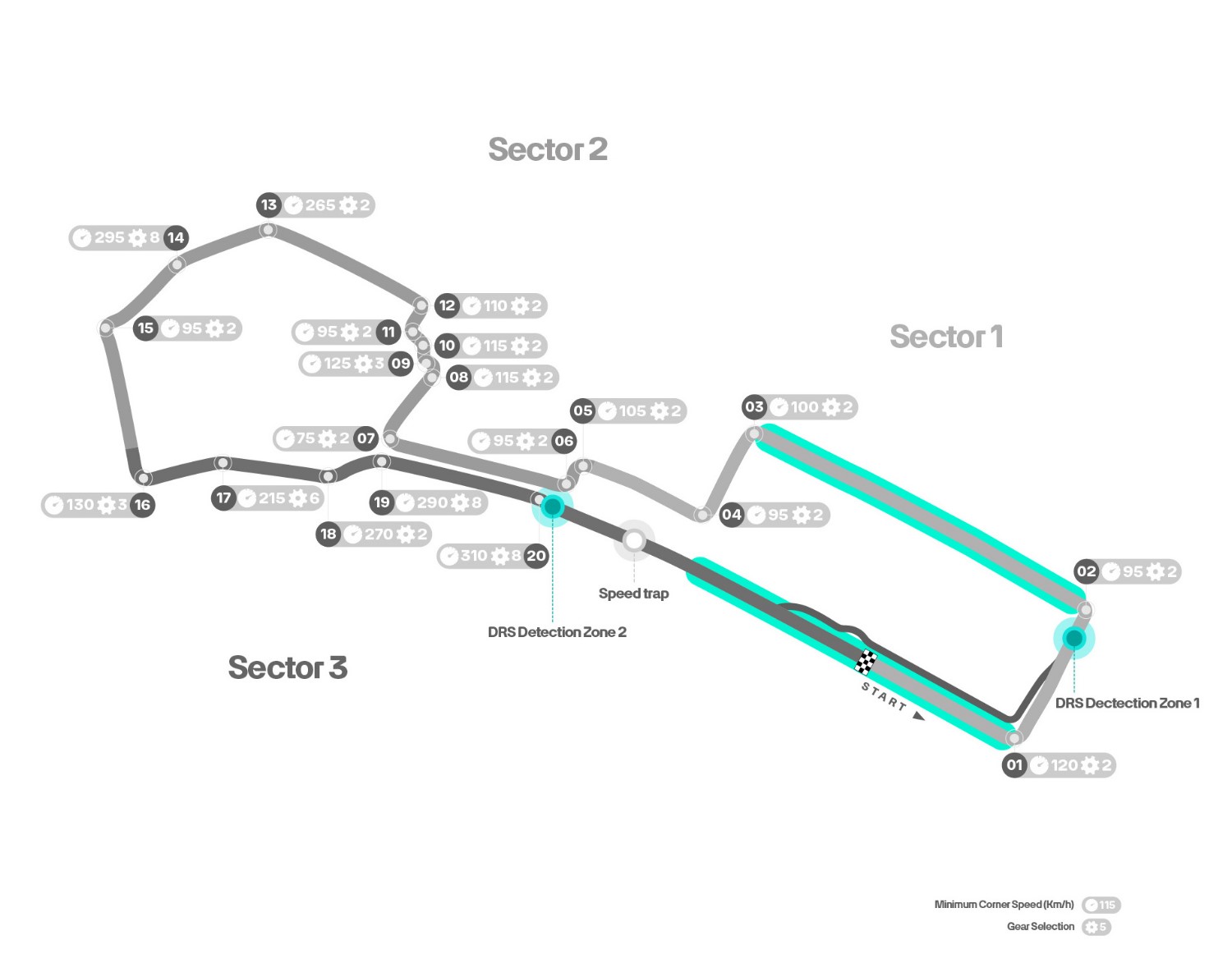
Circuit Insight
Jody Egginton (RB Technical Director)
“The Azerbaijan GP takes place on a street circuit in the capital city of Baku. On the F1 calendar since 2016 it usually delivers exciting racing. The six-kilometer-long circuit provides a good mix of challenges for the engineers and drivers with a long straight requiring good aerodynamic efficiency, as cars can exceed 345 km/h, while the 20 corners, which are predominantly slower speed, make strong demands on braking and traction performance. The circuit passes through the downtown streets including a section in the Old Quarter of the town and in this narrow section of track the proximity of the medieval walls adds a further risk factor for the drivers. This feature together with the more normal barrier-lined sections of the circuit combine to make Baku one of the most technically demanding on the F1 calendar and it can also provide a bit more unpredictability! Our test program for this race will be very busy because, in addition to the normal set up and tire work which we conduct at every event, we also have a number of important tests planned to learn more and optimize the cars around the new floor package which we first evaluated in Monza. In terms of the battle in the midfield, it remains very tight and we are staying focused on maximizing what we can extract from our cars with the goal of fighting for points with both our drivers.”
Race interruptions: Expect some form of stoppage in the race. In the six races held, there have been seven Safety Cars, two red flags and three Virtual Safety Cars. Strategy can be influenced by the timing of these. The softest compound of Pirelli’s range, the C5, will make its 2023 debut here.
Sprint: The first of six Sprint events this season. The format has altered somewhat, with the grid for both races being determined by separate qualifying sessions. Baku has never hosted a Sprint before. New for 2023, DRS will now be activated after one lap of green flag running in the Sprint.
Overtaking: Despite being a street circuit, Baku offers plenty of overtaking opportunities, with an average of 40 overtakes per race, not including the opening lap. Around 66% of those make use of DRS. It’s clearly not all about qualifying in Azerbaijan.
Strategy: Nevertheless, strategy is key in Baku, partly because the track has a lower-than-average pit-loss time of just 21 seconds. Despite higher speeds and hard braking at various points on the track, Pirelli brings its softest C3, C4 and C5 compounds.
Safety Car: 7 of the 8 races so far at Baku have involved either a Safety Car or a Virtual Safety Car; most have seen multiple disruptions. In both 2017 and 2021, the race was halted by a red flag, creating strategic variance. There has been an average of five DNFs each year.
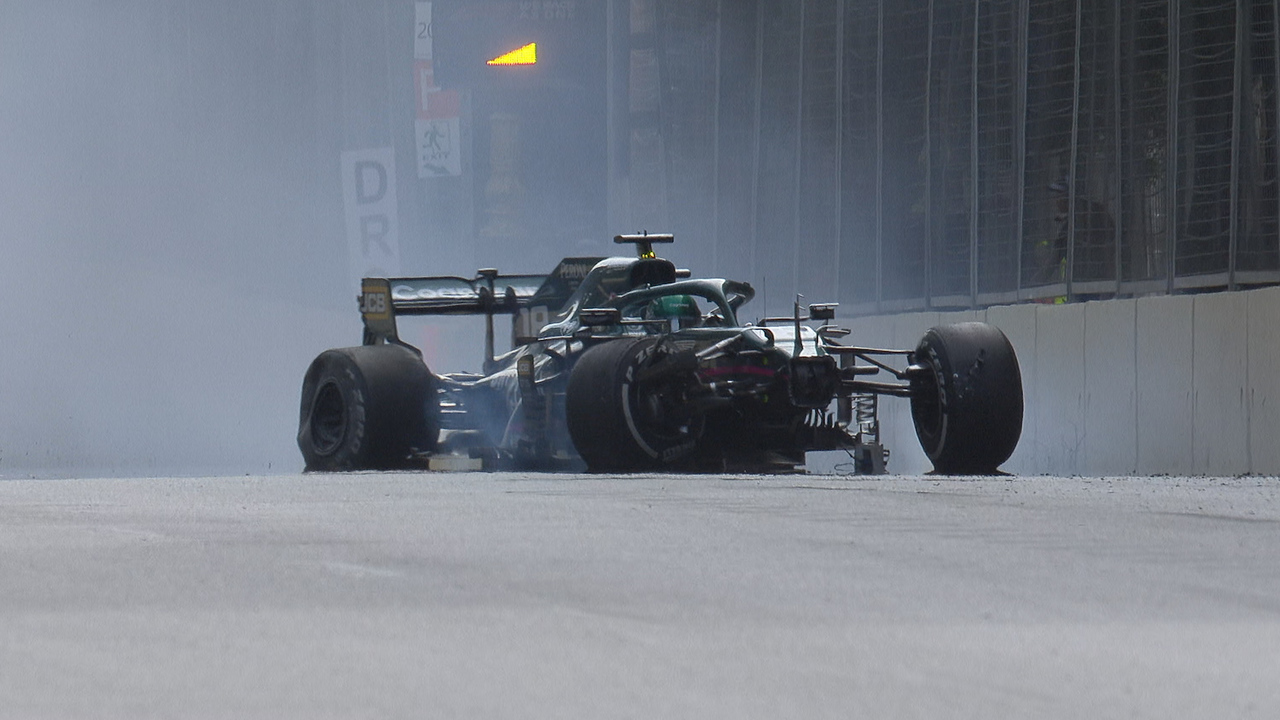
An iconic, and heartbreaking, Baku radio message 💔#AzerbaijanGP #F1
— Formula 1 (@F1) April 26, 2023
Weather Forecast
Friday – FP1 and FP2
Forecast: Sunny and warm. Temperature: 29C / 84F Chance of precipitation: <5%
Saturday – FP3 and Qualifying
Forecast: Sunny and warm. Temperature: 28C / 82F Chance of precipitation: <5%
Sunday – Race
Forecast: Sunny and warm. Temperature: 27C / 80F Chance of precipitation: <5%
6. The number of different winners in as many Formula 1 Grands Prix held in Baku. The first race, in 2016, went by the name of Grand Prix of Europe and was won by Nico Rosberg. From 2017 onwards, the race was renamed Azerbaijan Grand Prix and was won by Daniel Ricciardo, Lewis Hamilton, Valtteri Bottas, Sergio Perez and Max Verstappen (Twice). Ferrari has twice finished second, with Sebastian Vettel in 2016 and Kimi Räikkönen in 2018. Charles Leclerc was fourth in Baku in 2021 and Carlos Sainz finished fifth in 2018.
70. The number of different nationalities that make up the population of Baku. It owes its multi-ethnicity to having always been on the crossroads of commerce and travel, on the old Silk Road and more recently being home to a flourishing gas and oil industry.
400. The number of mud volcanoes in Azerbaijan. Small mounds, anything from a few centimeters to meters in height, they spew out a mixture of clay and water combined with saline substances such as salt, bromine and iodine as well as methane and hydrocarbon gases. Azerbaijan is home to half the world’s number of these volcanoes that can sometimes erupt up to 150 meters high.
700. The years that the Yanar Dag eternal flame has burned, due to natural gases burning beneath the sand. This 116 meter-high hill, also known as the “mountain of fire”, is situated on the Absheron peninsula, around 25 kilometers from Baku. Legend has it that the fire was started by an unwitting shepherd as he knocked out his pipe.
3000. The approximate number of carpets housed in Baku’s Carpet Museum. The shape of the actual building is also linked to its contents, presenting the form of a rolled up carpet.
Unlocking the Lap
The Baku City Circuit is one of the longest tracks of the season, with some of the most technical corners in Formula One. Both high-speed straights and tight, low-speed corners create a balancing act for car set-up.

Despite being another street circuit, Baku couldn’t be more different to Monaco. There are plenty of opportunities to overtake, with Turn One and Turn Three being the most popular spots to gain advantage.
The opening straight from pole to Turn One is just 170m – the second shortest of the year after Monaco, meaning plenty of skill is needed to prevent getting caught out at the start.
The first section comprises several 90-degree corners, but the most crucial of these is Turn Two. It precedes a long straight, so getting the exit spot on is critical to lap time. As with all these turns, the walls are ready to punish anybody who gets them wrong.
Turns Eight through 11 make up the famous Castle section. An aggressive entry to one of the tightest sections in Formula One is crucial to a good lap, before the climb up the hill and into the tricky, cambered T11, which sets up the fast sweepers that follow.
Turn 16 is another 90-degree left-hander and, while the wall on the exit is set back from the track, there is a large curb which can destabilize the car and catch drivers out. The corner precedes one of the longest full-throttle sections on the calendar and large amounts of time can be lost here.
From Turn 16 onwards, the next 1.5-miles is a fast, flat-out section, effectively becoming the longest straight of the calendar. It’s here that the claimed the fastest speed in F1 history was recorded, at 378km/h (234.9mph) in 2016.
Fact File: Azerbaijan Grand Prix
- The Baku City Circuit is the fourth longest on the F1 calendar this year – only Spa, Las Vegas and Jeddah are longer.
- A lap of the track sees drivers change gear 64 times, more than at any other circuit on the 2024 calendar.
- The Baku City Circuit also ranks highest in terms of braking energy. No track on the 2024 calendar has more braking zones of over 2G.
- Given the nature of a street circuit, it is perhaps no surprise that the Safety Car has been deployed five times across the last five races and is often required more than once across a Grand Prix.
- The section from the exit at Turn 16 to the braking zone for Turn 1 is the longest full-throttle passage of the year. It is around 200 meters longer than the segment from Turns 1 to 5 at Spa-Francorchamps.
- The 2.2 km start/finish straight therefore contributes to a very difficult restart for the leader, with a strong tow for the driver behind leaving them vulnerable into Turn 1.
- The name Baku derives from the shortened Persian name Bad-kuye, meaning “wind city”, along with Bad-kube, which means “wind-hitting.” Both terms refer to the famously consistently strong winds that blow through the city.
- Baku hosted an F1 Sprint weekend for the first time in 2023.
- The 2024 event is taking place in September for the first time, having previously taken place in the first half of the season (April or May).
- F1 first visited Baku in 2016, when the race was known as the European Grand Prix. It has been known as the Azerbaijan Grand Prix every year since.
- Most street circuits are not necessarily known for top speed, but Baku is different because of its long straights. Topping out at 322 km/h, cars can reach the second highest speed of the season so far – only in Miami have we seen a higher top speed of 324 km/h so far.
Pirelli Tires
As usual for a street circuit Pirelli has chosen the three softest dry compounds in the range, namely the C3 as Hard, the C4 as Medium and the C5 as Soft. The track is 6.003 kilometers in length and has remained pretty much unchanged since 2016, featuring 20 corners. Some of these, such as the first seven, are practically right angle turns, while others through the old part of the city are very slow and some are flat out, as they are part of a section of track that is treated as a two kilometer straight leading across the start-finish line. The track varies a lot in width, going from only seven meters at turn 8 to being wide enough to accommodate three cars abreast down the main straight.
As the circuit is normally open to city traffic, track evolution will be an important factor to consider when evaluating performance, while the weather can also play its part. Usually, it is quite hot in September, with temperatures definitely higher than those experienced when the race was held in April. Furthermore, track temperature can vary significantly depending on which parts are in sunlight or in the shade from the surrounding buildings, especially in the section that runs through the old city. Last but not least, the wind can upset the car’s handling and, coming from different directions, can catch the drivers unawares, as it is channelled by the surrounding buildings of the town.
The fastest ever top speed by a Formula 1 car in an official event was set in Baku, when Valtteri Bottas was clocked at 378 km/h in his Williams-Mercedes during qualifying for the inaugural event in 2016. The high speeds reached on the main straight will put the tires to the test, especially with the downforce generated by the current cars. With another section of track requiring the opposite aero set-up, the teams cannot opt to run too low a downforce level as they would then suffer in the slowest part of the track, where they will rely on tire-generated grip to get the most out of the car. Fortunately, the current Pirelli range has proved to be up to the task of dealing with these extremes of use.
When it comes to strategy, Baku is a typical one-stop race with the hardest tyre doing most of the work. Although a glance at the circuit layout might lead one to believe that overtaking is relatively straightforward, that is not at all the case. Given the hierarchy of the teams this year, with the performance differences within the two main groups being minimal, the effectiveness of DRS could play an important role, as will a team’s ability to react to the unexpected on a track where the chances of the race being neutralized are very high. In 2023, almost all drivers started the race on the Medium before switching to the Hard when the Safety Car came out on lap 11.
Sergio Perez is the only driver to have won here more than once. The Mexican won in Baku in 2021 and 2023, last time out also winning the Sprint, proving he clearly has an affinity for this type of track, as six of his seven Formula 1 wins have come on street circuits. If Checo is the king of Baku, Charles Leclerc can be said to be its prince of poles, as the Monegasque has secured the number one grid slot for the past three years from 2021 to 2023 and last year, he was also fastest in the Sprint Shootout. When it comes to the teams, the roles are reversed with Red Bull having the most wins (four) but no pole positions, while Ferrari has four poles, one of which courtesy of Sebastian Vettel, but it has never won. Indeed, the Italian team has only made it to the podium four times, while Mercedes and Red Bull have each done so on six occasions.
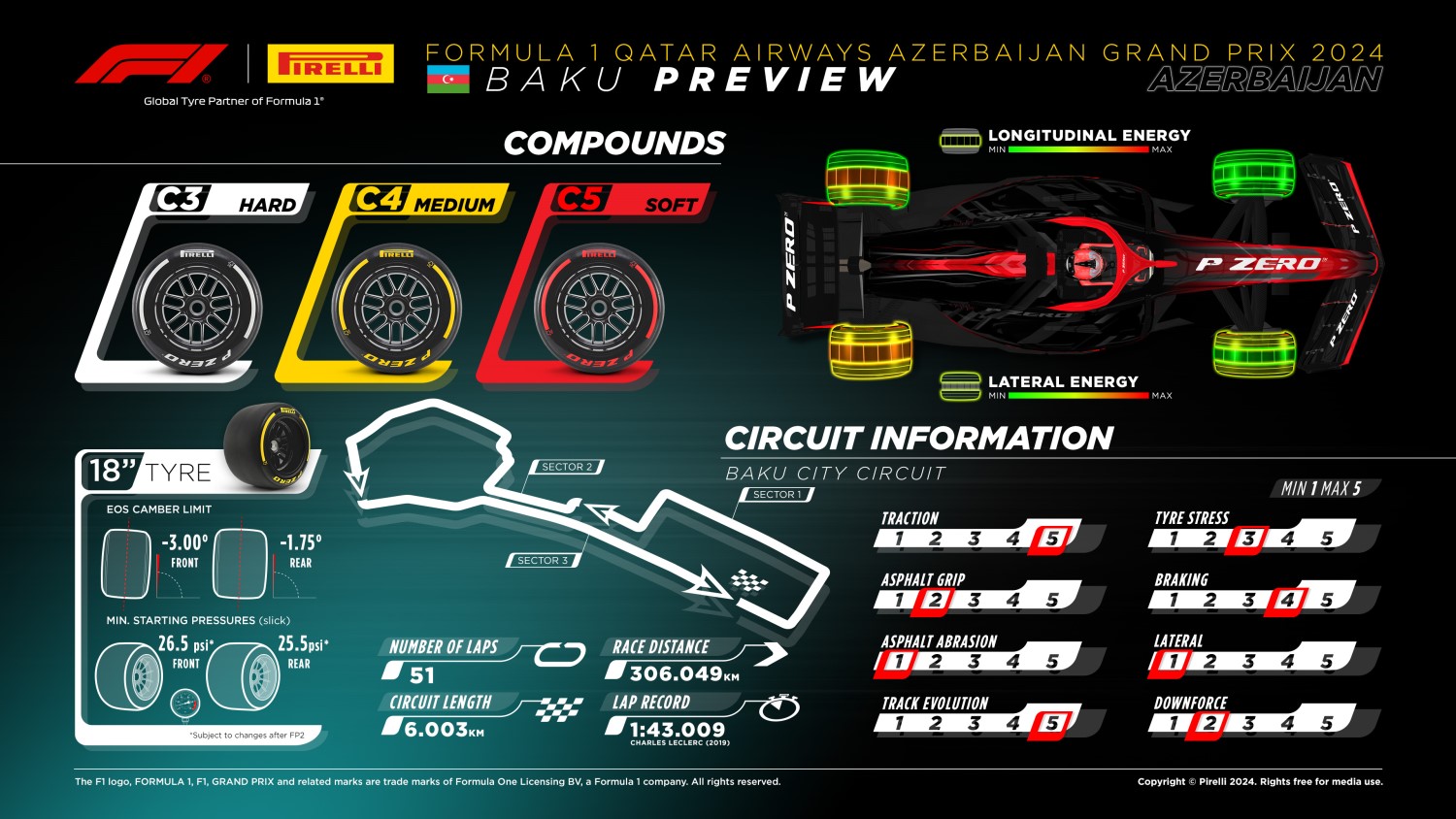
2023 Race Results
| POS | NO | DRIVER | NAT. | TEAM | BEHIND |
| 1 | 11 | Sergio Perez | MEX | Oracle Red Bull Racing | +0.000s |
| 2 | 1 | Max Verstappen | NED | Oracle Red Bull Racing | +2.137s |
| 3 | 16 | Charles Leclerc | MON | Scuderia Ferrari | +21.217s |
| 4 | 14 | Fernando Alonso | ESP | Aston Martin Aramco Cognizant | +22.024s |
| 5 | 55 | Carlos Sainz | ESP | Scuderia Ferrari | +45.491s |
| 6 | 44 | Lewis Hamilton | GBR | Mercedes AMG Petronas F1 Team | +46.145s |
| 7 | 18 | Lance Stroll | CAN | Aston Martin Aramco Cognizant | +51.617s |
| 8 | 63 | George Russell | GBR | Mercedes AMG Petronas F1 Team | +74.240s |
| 9 | 4 | Lando Norris | GBR | McLaren F1 Team | +80.376s |
| 10 | 22 | Yuki Tsunoda | JPN | Scuderia AlphaTauri | +83.862s |
| 11 | 81 | Oscar Piastri | AUS | McLaren F1 Team | +86.501s |
| 12 | 23 | Alex Albon | THA | Williams Racing | +88.623s |
| 13 | 20 | Kevin Magnussen | DEN | MoneyGram Haas F1 Team | +89.729s |
| 14 | 10 | Pierre Gasly | FRA | BWT Alpine F1 Team | +91.332s |
| 15 | 31 | Esteban Ocon | FRA | BWT Alpine F1 Team | +97.794s |
| 16 | 2 | Logan Sargeant | USA | Williams Racing | +100.943s |
| 18 | 27 | Valtteri Bottas | FIN | Alfa Romeo F1 Team Stake | +1 lap |
| 17 | 77 | Nico Hulkenberg | GER | MoneyGram Haas F1 Team | +1 lap |
| DNF | 24 | Zhou Guanyu | CHN | Alfa Romeo F1 Team Stake | 37 laps |
| DNF | 21 | Nyck de Vries | NED | Scuderia AlphaTauri | 9 laps |
* Provisional results. Note – Russell scored an additional point for setting the fastest lap of the race.
